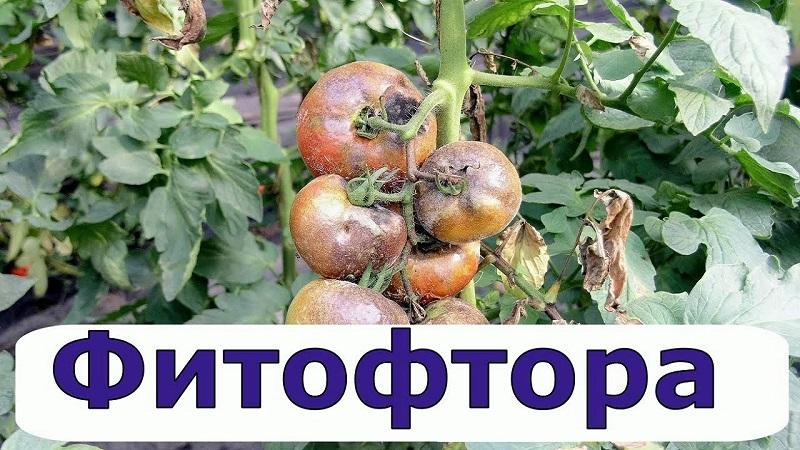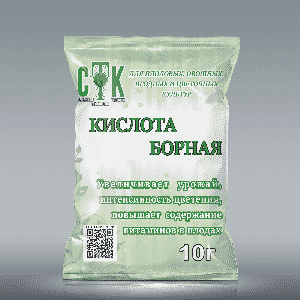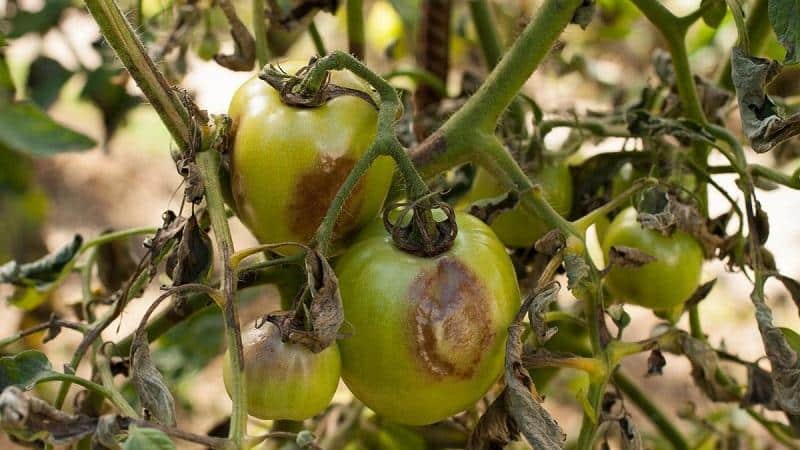We treat a popular tomato disease easily and quickly: boric acid against late blight on tomatoes
Dark spots on the stem, leaves and fruits - all this signals such a serious disease as late blight. When the first signs are detected, you need to act immediately so that the infection does not take over the entire greenhouse or a garden bed. Boric acid will help you with this. Read about how late blight occurs, how boron is useful for plants, and how to prepare a remedy for the disease yourself in this article.
The value of boron for plants
Boron is a unique element that a plant needs during its growth. In terms of importance for garden crops, experts place boron in second place after zinc, and sometimes in first. The main problem with this element is that it is not transferred from old tissues to new ones, so it is necessary to ensure its constant supply to tomatoes.
Boron is involved in the processes of photosynthesis and cell division, transportation of carbohydrates, cellular synthesis, activates enzymatic activity and has a beneficial effect on the metabolism of proteins, nucleins and hydrocarbons.
The most important properties of boron for plants:
- helps transfer sugars from leaves to seeds;
- promotes proper fetal formation;
- participates in the formation of the fruit and has a positive effect on the quality of seeds;
- increases the root system;
- helps absorb nitrogen;
- influences cell division, development and elongation.

Signs of boron deficiency in tomatoes
Most often, a lack of boron in tomatoes manifests itself in the inability to form fruits, which threatens yield loss. To help the plant, during flowering, spray the leaves with a solution of boric acid: 5-10 g of dry matter per 10 liters of water.
The main symptoms include the following:
- Flowers fall off without producing fruit.
- The tops of the shoots curl.
- The leaves, starting from the top of the plant, become lighter and curl.
- The veins darken.
- Many stepsons are formed, and the main stem begins to die.
- Leaves become brittle.
What is late blight
Late blight is a fungal disease. The causative agent is Phytophthora infestans. Translated from Greek phyto - plant, phthora - damage. The name of the disease speaks for itself: late blight can completely destroy a plant, from stem to fruit.
The most favorable environment for the development of this disease is a greenhouse with high humidity and frequent temperature changes. Constant fogs on the land also have a negative impact.
The causative agent of late blight spreads using zoosporangia. These are single-celled reproductive organs of this type of fungus, which form zoospores - motile cells equipped with flagella. They have increased resistance to adverse conditions, so they spread quickly and easily, infecting everything around them.
Important! Most gardeners agree that the only way to finally get rid of late blight is by burning diseased plants.

Is the disease treated with boron?
Boron is successfully used to feed tomatoes, generally strengthen plants and improve yields. At the same time, he has already managed to establish himself as a fighter against late blight.
Note! This fungus infects not only the plant, but also the soil, so feeding tomatoes with boron directly into the soil is an excellent preventive measure against the development of the disease.
It is also recommended to spray the plants themselves with a solution of boric acid.
Preparation of boric acid solution
You will need water and boric acid powder. To prepare the solution, you need to dilute the powder in water in a ratio of 5-10 g per 10 liters of water.
Boric acid dissolves very poorly, so first you should dilute it in a small amount of hot water (but not boiling water, the optimal temperature is 50 degrees) and pour it into a bucket. Mix everything. The solution of boric acid against late blight on tomatoes is ready.

Processing methods
Depending on what part of the plant needs to be treated, there are three main ways to combat late blight.
Soaking the seeds
To prepare for planting, seeds are soaked in the solution for 24 hours. 0.2 g of acid is diluted in 1 liter of water. To prevent the seeds from floating, they should be wrapped in a gauze bag before soaking. The result of such preparation is improved germination and prevention of late blight..
Spraying tomatoes
Most often, the fungus affects already mature adult plants. Treating tomatoes with boric acid solution is the cheapest and most effective method for obtaining a healthy harvest.
The solution should be sprayed on all green parts of the plant. A week before the procedure, it is recommended to spray the tomatoes with a weak solution. potassium permanganate. You can fix the result by treating with a weak solution. iodine a week after using boric acid.
Foliar feeding
For this method, use a solution of 10 g per 10 liters of water.It is important to water the plant before fertilizing, as boric acid can burn the roots. Fertilizing is carried out by spraying the soil three times a year.
Control of late blight in greenhouses and open ground
 The greenhouse has a very favorable environment for the occurrence of disease. Warm and humid air, a closed space - all this only contributes to the development of Phytophthora zoosporangia. Spores can also be found on the walls of the greenhouse. Therefore, in addition to spraying tomatoes and disinfecting the soil with boric acid, it is worth treating the internal walls and paths with the solution.
The greenhouse has a very favorable environment for the occurrence of disease. Warm and humid air, a closed space - all this only contributes to the development of Phytophthora zoosporangia. Spores can also be found on the walls of the greenhouse. Therefore, in addition to spraying tomatoes and disinfecting the soil with boric acid, it is worth treating the internal walls and paths with the solution.
You should not collect seeds for future sowing from a greenhouse with diseased plants (even from the remaining healthy tomatoes).
It is advisable to spray once a week for a month or two. This will stop the development of the disease and strengthen the tomatoes.
On the street, all operations to combat late blight are recommended to be done after rain. Firstly, it will protect the plant roots from being burned. Secondly, it is unlikely that it will rain again soon, which means that boric acid on the leaves will last longer.
Both in the greenhouse and in the open ground it is necessary to limit watering tomatoesso as not to create an additional favorable microclimate for the development of fungus.
Processing time for tomatoes
There are three stages of planned treatment of tomatoes with boric acid:
- Before flowering, when the buds are just beginning to form.
- At the height of flowering.
- At the beginning of fruiting, when the fruits acquire a color characteristic of their variety.
Also, spraying should be done as needed if late blight does appear.
Basic mistakes
Most often, errors are made during the processing process, as well as during preventive and additional measures and solution preparation:
- There is no need to water the plants during the highest disease activity - this will only worsen the situation. In open ground you can build a canopy.
- You should not use several other different products in parallel with boric acid. They may not be compatible, and the fruit is likely to become poisonous due to the large amount of chemicals.
- It is important to completely dissolve the powder in the water, otherwise you risk burning the plant.

Reviews from gardeners
Due to its effectiveness, boric acid is loved by many gardeners. And even a beginner can prepare such a product - no special tools or knowledge are required. Gardeners speak very positively about this product. Here are some of the reviews.
Maria, Perm: “Boric acid is a simple and accessible fertilizer for every gardener. If you use it correctly in tomato beds, it will only benefit the plants. For such care they will definitely thank you with a generous harvest.”
Vladimir, Tver: “I always have boric acid in stock. I keep it for my garden. I process not only tomatoes, but also other vegetables and trees. The result is noticeable immediately: the plants improve their appearance, flowering and fruiting. I consider boric acid an extremely useful fertilizer.”
Valery, Vologda: “I am an experienced vegetable grower and have long noticed the peculiarities of the condition of tomatoes depending on the content of elements in the soil. As soon as I see characteristic signs of boron deficiency, I immediately try to treat the plants with boric acid. I use powdered fertilizer and dilute it strictly in the concentration indicated in the instructions. It is important. If you take less, you won’t get the desired effect; if you take more, you can burn the leaves and roots of the plants.With the correct use of boric acid, tomatoes begin to bloom vigorously, the ovary does not fall off, the fruits turn out healthy, and the tomatoes themselves also look normal.”

Let's sum it up
Boric acid is a cheap and effective remedy for late blight on tomatoes, which does not require much effort in preparation and use. The main thing in the fight against the disease is prevention. The use of a boric acid solution in the beds will prevent dangerous fungus from arising, and will also improve the condition of the tomatoes and the quality of the harvest.